
Illustrative Math Alignment: Grade 7 Unit 7
Expressions, Equations, and Inequalities
Lesson 9: Dealing with Negative Numbers
Use the following Media4Math resources with this Illustrative Math lesson.
| Thumbnail Image | Title | Body | Curriculum Topic |
|---|---|---|---|

|
Lesson Plan--Linear Functions and Equations (MS)--Lesson 3--Solving Linear Equations | Solving Linear EquationsThis is the third lesson in a five-part series on linear equations for middle school students. In this lesson, students develop skills to solve one-variable linear equations using inverse operations, balancing equations, and verifying solutions. They will learn to solve equations with one solution, no solution, or infinitely many solutions. The lesson aligns with Common Core Standards 8.EE.C.7 and 8.EE.C.7a. |
Solving One-Step Equations and Solving Two-Step Equations |
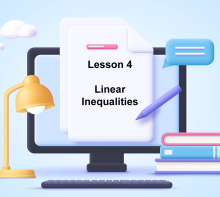
|
Lesson Plan--Linear Functions and Equations (MS)--Lesson 4--Linear Inequalities | Lesson Plan: Linear InequalitiesThis is the fourth lesson in a five-part series on linear equations and inequalities designed for middle school students. In this lesson, students explore the fundamentals of linear inequalities, including solving inequalities algebraically and graphing solution sets on the coordinate plane. Through step-by-step instruction, students learn to interpret inequality symbols, apply inverse operations, and determine whether to use solid or dashed boundary lines in graphs. The lesson includes real-world applications, such as budgeting constraints, work-hour limits, and spending allowances, demonstrating how linear inequalities are used in everyday decision-making. Aligned with Common Core Standards 6.NS.C.7a, 6.EE.B.5, 8.EE.B.5, and 8.EE.C.7b, this lesson builds on students’ prior knowledge of linear equations while introducing a broader understanding of algebraic inequalities. |
Inequalities |
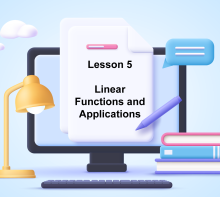
|
Lesson Plan--Linear Functions and Equations (MS)--Lesson 5--Linear Functions and Applications | Lesson Plan: Linear Functions and ApplicationsThis is the fifth and final lesson in a five-part series on linear equations and inequalities designed for middle school students. In this lesson, students explore linear functions in-depth, learning how to represent them using equations, tables, and graphs. They will analyze key function properties, including slope, y-intercept, domain, and range, to develop a complete understanding of how linear functions behave. The lesson focuses on real-world applications, demonstrating how linear functions are used in various fields such as finance, physics, and business. Students will solve problems involving rates of change, cost analysis, and motion, reinforcing the practical significance of linear functions. Through guided practice and hands-on activities, they will interpret linear relationships and predict outcomes using function models. |
Applications of Linear Functions |
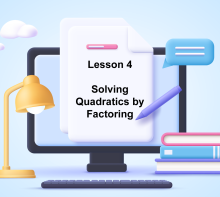
|
Lesson Plan--Quadratics--Lesson 4--Solving Quadratic Equations by Factoring | Lesson Plan: Solving Quadratic Equations by Factoring In this fourth lesson of the Quadratic Functions and Equations Unit, students will learn how to solve quadratic equations using factoring. Factoring is a fundamental algebraic technique that allows students to break down quadratic expressions into simpler binomial factors to find the equation’s solutions, or roots. Students will: |
Factoring Quadratics |
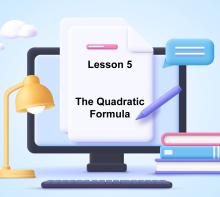
|
Lesson Plan--Quadratics--Lesson 5--Solving Quadratic Equations Using the Quadratic Formula | Lesson Plan: Solving Quadratic Equations Using the Quadratic Formula In this fifth lesson of the Quadratic Functions and Equations Unit, students will learn how to solve quadratic equations using the quadratic formula. The quadratic formula provides a reliable method for finding the roots of any quadratic equation, even when factoring or completing the square is not practical. Students will: |
Quadratic Formula |

|
Lesson Plan--Systems of Equations--Lesson 1--Introduction to Systems | Lesson Plan: Introduction to Systems of Equations In this first lesson of the Systems of Equations Unit, students will be introduced to the concept of systems of equations. A system of equations consists of two or more equations that share common variables, and solving these systems helps in finding values that satisfy all equations simultaneously. Students will: |
Solving Systems of Equations |
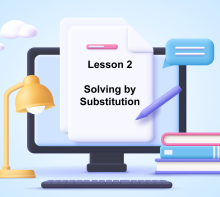
|
Lesson Plan--Systems of Equations--Lesson 2--Solving by Substitution | Lesson Plan: Solving Systems of Equations by Substitution In this second lesson of the Systems of Equations Unit, students will learn how to solve systems of equations using the substitution method. Substitution is an algebraic technique that allows students to find the solution to a system by replacing one variable with an equivalent expression. Students will: |
Solving Systems of Equations |

|
Lesson Plan--Systems of Equations--Lesson 3--Solving by Elimination | Lesson Plan: Solving Systems of Equations by Elimination In this third lesson of the Systems of Equations Unit, students will learn how to solve systems of equations using the elimination method. This algebraic technique allows students to eliminate one variable by adding or subtracting equations, making it easier to find the solution. Students will: |
Solving Systems of Equations |
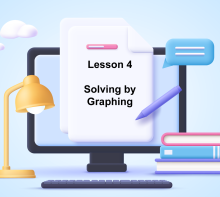
|
Lesson Plan--Systems of Equations--Lesson 4--Solving by Graphing | Lesson Plan: Solving Systems of Equations by Graphing In this fourth lesson of the Systems of Equations Unit, students will learn how to solve systems of equations using the graphing method. Graphing is a visual approach that helps students understand the meaning of a system's solution by identifying the point where two lines intersect. Students will: |
Solving Systems of Equations |
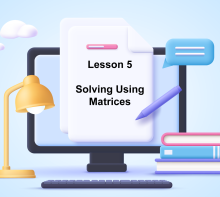
|
Lesson Plan--Systems of Equations--Lesson 5--Solving Using Matrices | Lesson Plan Solving Systems Using Matrices In this fifth lesson of the Systems of Equations Unit, students will learn how to solve systems of equations using matrices. Matrices provide an efficient way to organize and manipulate systems of equations, particularly for larger systems. Students will: |
Solving Systems of Equations |

|
Lesson Plan--Systems of Equations--Lesson 6--Zero or Infinite Solutions | Lesson Plan: Solving Systems of Equations with No Solution or Infinite Solutions In this sixth lesson of the Systems of Equations Unit, students will learn how to identify and solve systems of equations that have no solution or infinitely many solutions. Understanding these special cases is crucial for analyzing relationships between linear equations. Students will: |
Solving Systems of Equations |

|
Lesson Plan--Systems of Equations--Lesson 7--Applications of Systems | Lesson Plan: Applications of Systems of Equations In this seventh lesson of the Systems of Equations Unit, students will explore real-world applications of systems of equations. Systems of equations are used in various fields, including business, science, engineering, and economics, to model and solve practical problems. Students will: |
Applications of Linear Systems |

|
Lesson Plan--Systems of Equations--Lesson 8--Systems of Inequalities | Lesson Plan: Systems of Inequalities In this final lesson of the Systems of Equations Unit, students will learn how to solve and graph systems of inequalities. Unlike systems of equations, which have a single solution point or no solution, systems of inequalities have solution regions that represent multiple possible solutions. Students will: |
Solving Systems of Equations |
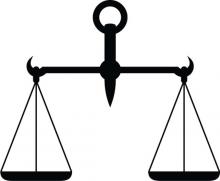
|
Math Clip Art--Equations and Inequalities--Equation Models--Balance Scale 1 | Math Clip Art--Equations and Inequalities--Equation Models--Balance Scale 1
This is part of a collection of math clip art images about equations and inequalities. |
Applications of Equations and Inequalities |
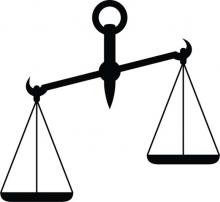
|
Math Clip Art--Equations and Inequalities--Equation Models--Balance Scale 2 | Math Clip Art--Equations and Inequalities--Equation Models--Balance Scale 2
This is part of a collection of math clip art images about equations and inequalities. |
Applications of Equations and Inequalities |
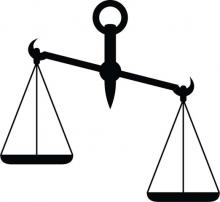
|
Math Clip Art--Equations and Inequalities--Equation Models--Balance Scale 3 | Math Clip Art--Equations and Inequalities--Equation Models--Balance Scale 3
This is part of a collection of math clip art images about equations and inequalities. |
Applications of Equations and Inequalities |

|
Math Clip Art--Equations and Inequalities--Equation Models--Balanced Equation | Math Clip Art--Equations and Inequalities--Equation Models--Balanced Equation
This is part of a collection of math clip art images about equations and inequalities. |
Applications of Equations and Inequalities |
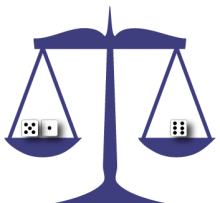
|
Math Clip Art--Equations and Inequalities--Equation Models--Balanced Equation 1 | Math Clip Art--Equations and Inequalities--Equation Models--Balanced Equation 1
This is part of a collection of math clip art images about equations and inequalities. |
Applications of Equations and Inequalities |
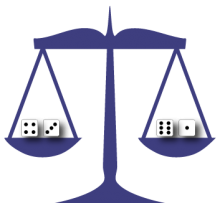
|
Math Clip Art--Equations and Inequalities--Equation Models--Balanced Equation 2 | Math Clip Art--Equations and Inequalities--Equation Models--Balanced Equation 2
This is part of a collection of math clip art images about equations and inequalities. |
Applications of Equations and Inequalities |
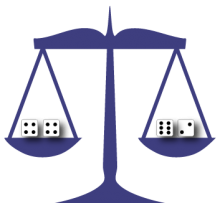
|
Math Clip Art--Equations and Inequalities--Equation Models--Balanced Equation 3 | Math Clip Art--Equations and Inequalities--Equation Models--Balanced Equation 3
This is part of a collection of math clip art images about equations and inequalities. |
Applications of Equations and Inequalities |
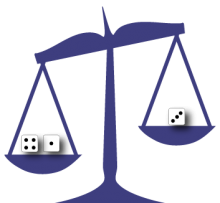
|
Math Clip Art--Equations and Inequalities--Equation Models--Unbalanced Equation 1 Left | Math Clip Art--Equations and Inequalities--Equation Models--Unbalanced Equation 1 Left
This is part of a collection of math clip art images about equations and inequalities. |
Applications of Equations and Inequalities |
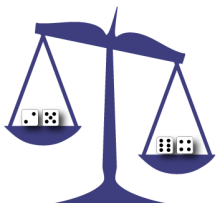
|
Math Clip Art--Equations and Inequalities--Equation Models--Unbalanced Equation 1 Right | Math Clip Art--Equations and Inequalities--Equation Models--Unbalanced Equation 1 Right
This is part of a collection of math clip art images about equations and inequalities. |
Applications of Equations and Inequalities |
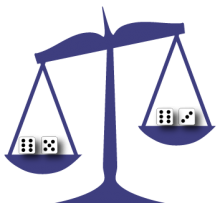
|
Math Clip Art--Equations and Inequalities--Equation Models--Unbalanced Equation 2 Left | Math Clip Art--Equations and Inequalities--Equation Models--Unbalanced Equation 2 Left
This is part of a collection of math clip art images about equations and inequalities. |
Applications of Equations and Inequalities |
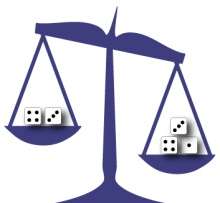
|
Math Clip Art--Equations and Inequalities--Equation Models--Unbalanced Equation 2 Right | Math Clip Art--Equations and Inequalities--Equation Models--Unbalanced Equation 2 Right
This is part of a collection of math clip art images about equations and inequalities. |
Applications of Equations and Inequalities |

|
Math Clip Art--Equations and Inequalities--Equation Models--Unbalanced Equation 3 Left | Math Clip Art--Equations and Inequalities--Equation Models--Unbalanced Equation 3 Left
This is part of a collection of math clip art images about equations and inequalities. |
Applications of Equations and Inequalities |
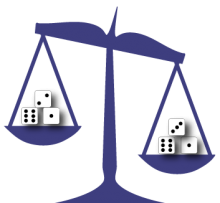
|
Math Clip Art--Equations and Inequalities--Equation Models--Unbalanced Equation 3 Right | Math Clip Art--Equations and Inequalities--Equation Models--Unbalanced Equation 3 Right
This is part of a collection of math clip art images about equations and inequalities. |
Applications of Equations and Inequalities |

|
Math Clip Art--Equations and Inequalities--Equation Models--Unbalanced Equation Left | Math Clip Art--Equations and Inequalities--Equation Models--Unbalanced Equation Left
This is part of a collection of math clip art images about equations and inequalities. |
Applications of Equations and Inequalities |

|
Math Clip Art--Equations and Inequalities--Equation Models--Unbalanced Equation Right | Math Clip Art--Equations and Inequalities--Equation Models--Unbalanced Equation Right
This is part of a collection of math clip art images about equations and inequalities. |
Applications of Equations and Inequalities |

|
Math Clip Art--Equations and Inequalities--Inequalities | Math Clip Art--Equations and Inequalities--Inequalities
This is part of a collection of math clip art images about equations and inequalities. |
Inequalities |
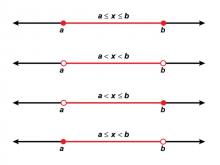
|
Math Clip Art--Equations and Inequalities--Inequalities--Compound Inequalities Set 1 | Math Clip Art--Equations and Inequalities--Inequalities--Compound Inequalities Set 1
This is part of a collection of math clip art images about equations and inequalities. |
Inequalities |
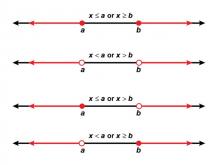
|
Math Clip Art--Equations and Inequalities--Inequalities--Compound Inequalities Set 2 | Math Clip Art--Equations and Inequalities--Inequalities--Compound Inequalities Set 2
This is part of a collection of math clip art images about equations and inequalities. |
Inequalities |
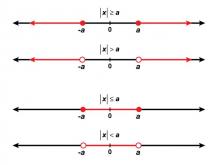
|
Math Clip Art--Equations and Inequalities--Inequalities--Compound Inequalities Set 3 | Math Clip Art--Equations and Inequalities--Inequalities--Compound Inequalities Set 3
This is part of a collection of math clip art images about equations and inequalities. |
Inequalities |
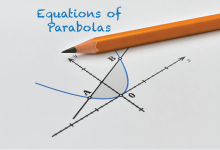
|
Math Clip Art--Quadratics Concepts--Equations of Parabolas 01 | Math Clip Art--Quadratics Concepts--Equations of Parabolas 01TopicQuadratics DescriptionThis math clip art image introduces the concept of equations of parabolas, a fundamental topic in quadratic functions. The image showcases a blue parabola drawn on graph paper, with clearly labeled x and y axes. Points are marked on the graph, providing a visual representation of key points on a parabola. |
Graphs of Quadratic Functions |
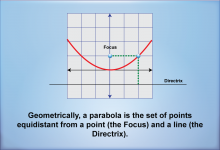
|
Math Clip Art--Quadratics Concepts--Equations of Parabolas 02 | Math Clip Art--Quadratics Concepts--Equations of Parabolas 02TopicQuadratics DescriptionThis math clip art image illustrates the geometric definition of a parabola. It shows a red parabola on a grid, with clearly labeled focus and directrix. The parabola is symmetric around the vertical axis, demonstrating a key property of parabolas. |
Graphs of Quadratic Functions |
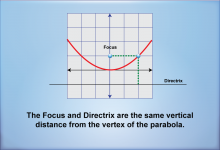
|
Math Clip Art--Quadratics Concepts--Equations of Parabolas 03 | Math Clip Art--Quadratics Concepts--Equations of Parabolas 03TopicQuadratics DescriptionThis math clip art image builds upon the previous concept, showing a red parabola opening upwards on a grid. The focus is clearly marked above the vertex, and the directrix is represented as a horizontal line below the vertex. This visual representation emphasizes a crucial property of parabolas: the focus and directrix are equidistant from the vertex. |
Graphs of Quadratic Functions |
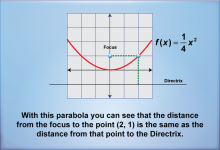
|
Math Clip Art--Quadratics Concepts--Equations of Parabolas 04 | Math Clip Art--Quadratics Concepts--Equations of Parabolas 04TopicQuadratics DescriptionThis math clip art image presents a red parabola on a grid with its equation f(x) = 1/4x2. The focus and directrix are clearly labeled, demonstrating the symmetry of the parabola. A specific point (2, 1) is highlighted to show that its distance from the focus is equal to its distance from the directrix. |
Graphs of Quadratic Functions |
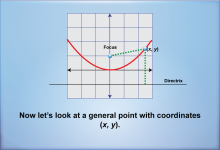
|
Math Clip Art--Quadratics Concepts--Equations of Parabolas 05 | Math Clip Art--Quadratics Concepts--Equations of Parabolas 05TopicQuadratics DescriptionThis math clip art image introduces a more general approach to understanding parabolas. It depicts a parabola with its focus at (0, f) and includes a directrix. The key feature of this image is the marking of a general point with coordinates (x, y) on the parabola. |
Graphs of Quadratic Functions |
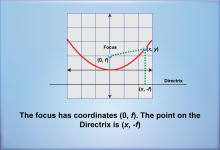
|
Math Clip Art--Quadratics Concepts--Equations of Parabolas 06 | Math Clip Art--Quadratics Concepts--Equations of Parabolas 06TopicQuadratics DescriptionThis math clip art image builds upon the previous concept, showing a parabola with its focus at (0, f) and a directrix line below it. The image specifically labels the point on the directrix as (x, -f), corresponding to the x-coordinate of a point on the parabola. |
Graphs of Quadratic Functions |
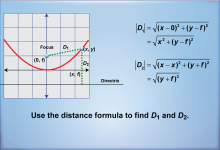
|
Math Clip Art--Quadratics Concepts--Equations of Parabolas 07 | Math Clip Art--Quadratics Concepts--Equations of Parabolas 07TopicQuadratics DescriptionThis math clip art image advances the concept of deriving a parabola's equation. It shows a parabola with its focus at (0, f) and directrix, and introduces calculations for distances D1 and D2. These distances represent the key relationship that defines a parabola: the equidistance of any point on the parabola from the focus and the directrix. |
Graphs of Quadratic Functions |
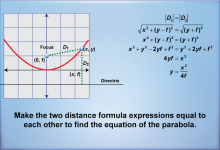
|
Math Clip Art--Quadratics Concepts--Equations of Parabolas 08 | Math Clip Art--Quadratics Concepts--Equations of Parabolas 08TopicQuadratics DescriptionThis math clip art image presents the culmination of the parabola equation derivation process. It shows a parabola with its focus at (0, f) and directrix, along with distances D1 and D2 illustrated from a point (x, y) on the parabola to the focus and directrix, respectively. The image also includes the equation derivation, demonstrating how to equate the two distance formulas. |
Graphs of Quadratic Functions |

|
Math Clip Art--Quadratics Concepts--Equations of Parabolas 09 | Math Clip Art--Quadratics Concepts--Equations of Parabolas 09TopicQuadratics DescriptionThe ninth image in this collection visually reinforces the concepts previously introduced. It illustrates a graph of a parabola with a focus point (a, b), directrix y = c, and marking the distances D1 and D2. This composition emphasizes the link between the geometric definition of a parabola and its mathematical function. |
Graphs of Quadratic Functions |
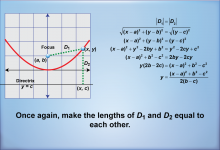
|
Math Clip Art--Quadratics Concepts--Equations of Parabolas 10 | Math Clip Art--Quadratics Concepts--Equations of Parabolas 10TopicQuadratics DescriptionThis image continues the trend of analysis by showing the process of deriving the equation for a parabola. The focus at point (a, b), the directrix at y = c, and the marked distances D1 and D2 is crucial for visual learning and conceptual understanding. With these elements illustrated, the image reinforces the message of equidistance between a point on the parabola and its defining attributes, the focus and directrix. It serves as a key teaching tool to show how algebraic formulae arise from geometrical properties. |
Graphs of Quadratic Functions |
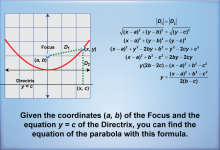
|
Math Clip Art--Quadratics Concepts--Equations of Parabolas 11 | Math Clip Art--Quadratics Concepts--Equations of Parabolas 11TopicQuadratics DescriptionThe final image in this set encapsulates the concepts presented throughout the earlier illustrations. It closely resembles the previous image while maintaining a focus on calculating the equation of a parabola. Here, the focus is again at (a, b) while the directrix follows the line y = c; D1 and D2 are marked, reiterating the need for distance calculations. |
Graphs of Quadratic Functions |
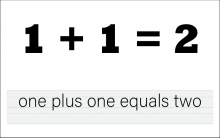
|
Math Clip Art--The Language of Math--Numbers and Equations 01 | Math Clip Art--The Language of Math--Numbers and Equations 01TopicThe Language of Math DescriptionThis image from the Language of Math collection illustrates the equation "1+1=2" using both numerical symbols and words. It serves as a fundamental building block in teaching basic addition and the concept of equality in mathematics. By presenting the equation in both numerical and verbal forms, this clip art reinforces the connection between mathematical symbols and their linguistic representations. This dual presentation is crucial for developing students' ability to translate between mathematical language and everyday language. |
Numerical Expressions |
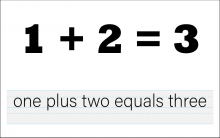
|
Math Clip Art--The Language of Math--Numbers and Equations 02 | Math Clip Art--The Language of Math--Numbers and Equations 02TopicThe Language of Math DescriptionThis clip art image from the Language of Math series depicts the equation "1+2=3" in both numerical and word form. It builds upon the previous image, introducing the concept of adding a two-digit number to a one-digit number. The visual representation of this equation helps students understand how numbers combine to form larger values. By presenting the equation in both formats, it reinforces the connection between mathematical symbols and their verbal expressions, a crucial skill in mathematical literacy. |
Numerical Expressions |
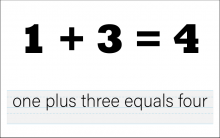
|
Math Clip Art--The Language of Math--Numbers and Equations 03 | Math Clip Art--The Language of Math--Numbers and Equations 03TopicThe Language of Math DescriptionThis clip art from the Language of Math collection presents the equation "1+3=4" in both numerical and word formats. It continues the progression of addition concepts, now introducing the sum of four. The dual representation of the equation reinforces the connection between mathematical symbols and their verbal counterparts. This visual aid helps students understand how numbers combine to create larger values and introduces the concept of "one more than" the previous equation. |
Numerical Expressions |
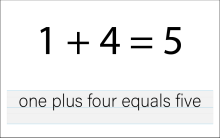
|
Math Clip Art--The Language of Math--Numbers and Equations 04 | Math Clip Art--The Language of Math--Numbers and Equations 04TopicThe Language of Math DescriptionThis clip art image from the Language of Math series illustrates the equation "1+4=5" in both numerical and word form. It continues the pattern of increasing sums, now reaching five. The dual representation of the equation helps students connect the abstract mathematical symbols with their concrete verbal expressions. This visual aid is crucial in developing number sense and understanding the concept of addition, particularly how combining smaller numbers results in larger ones. |
Numerical Expressions |
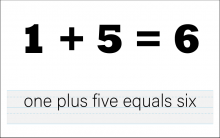
|
Math Clip Art--The Language of Math--Numbers and Equations 05 | Math Clip Art--The Language of Math--Numbers and Equations 05TopicThe Language of Math DescriptionThis clip art from the Language of Math collection showcases the equation "1+5=6" in both numerical and word formats. It continues the series of addition equations, now introducing the sum of six. The simultaneous presentation of the equation in symbols and words reinforces the connection between mathematical language and everyday language. This visual representation helps students understand how numbers combine to form larger values and introduces the concept of "five more than" the initial number. |
Numerical Expressions |
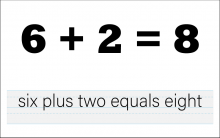
|
Math Clip Art--The Language of Math--Numbers and Equations 06 | Math Clip Art--The Language of Math--Numbers and Equations 06TopicThe Language of Math DescriptionThis image illustrates the equation "6+2=8" in both numerical and word form, continuing the progression of addition concepts with larger numbers. The dual representation reinforces the connection between mathematical symbols and their verbal expressions, a crucial skill in developing mathematical literacy. This visual aid helps students understand how numbers combine to create larger values and introduces the concept of adding to a number greater than 5. |
Numerical Expressions |
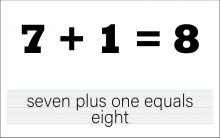
|
Math Clip Art--The Language of Math--Numbers and Equations 07 | Math Clip Art--The Language of Math--Numbers and Equations 07TopicThe Language of Math DescriptionThis clip art from the Language of Math collection showcases the equation "7+1=8" in both numerical and word formats. It continues the series of addition equations, now introducing the concept of adding 1 to a larger number. The simultaneous presentation of the equation in symbols and words reinforces the connection between mathematical language and everyday language. This visual representation helps students understand how numbers combine and introduces the concept of "one more than" a given number. |
Numerical Expressions |